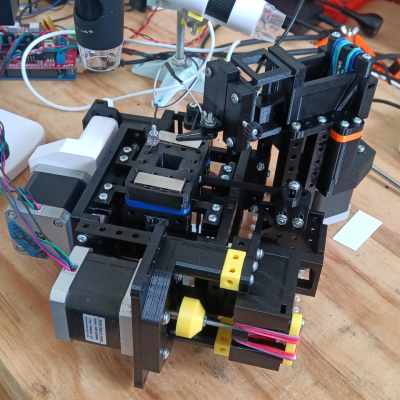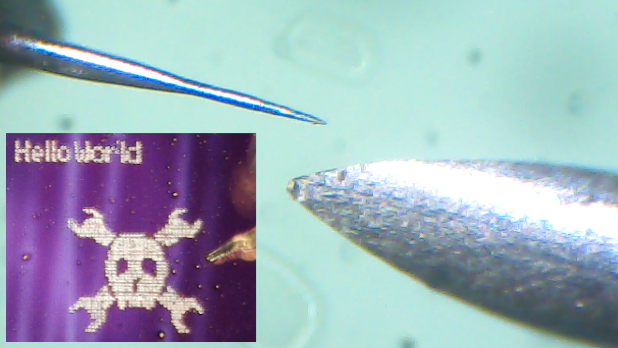3D printing has transformed how hobbyists fabricate things, but what additional doors would open if we could go even smaller? The µRepRap (RepRapMicron) project aims to bring fabrication at the micron and sub-micron scale to hobbyists the same way RepRap strove to make 3D printing accessible. New developments by [Vik Olliver] show a promising way forward, and also highlight the many challenges of going so small.

How exactly would a 3D printer do micro-fabrication? Not by squirting plastic from a nozzle, but by using a vanishingly tiny needle-like effector (which can be made at any workbench via electrochemical erosion) to pick up a miniscule amount of resin one dab a time, curing it with UV after depositing it like a brush deposits a dot of ink.
By doing so repeatedly and in a structured way, one can 3D print at a micro scale one “pixel” (or voxel, more accurately) at a time. You can see how small they’re talking in the image in the header above. It shows a RepRapMicron tip (left) next to a 24 gauge hypodermic needle (right) which is just over half a millimeter in diameter.
Moving precisely and accurately at such a small scale also requires something new, and that is where flexures come in. Where other 3D printers use stepper motors and rails and belts, RepRapMicron leverages work done by the OpenFlexure project to achieve high-precision mechanical positioning without the need for fancy materials or mechanisms. We’ve actually seen this part in action, when [Vik Olliver] amazed us by scribing a 2D micron-scale Jolly Wrencher 1.5 mm x 1.5 mm in size, also visible in the header image above.
Using a tiny needle to deposit dabs of UV resin provides the platform with a way to 3D print, but there are still plenty of unique problems to be solved. How does one observe such a small process, or the finished print? How does one handle such a tiny object, or free it from the build platform without damaging it? The RepRapMicron project has solutions lined up for each of these and more, so there’s a lot of discovery waiting to be done. Got ideas of your own? The project welcomes collaboration. If you’d like to watch the latest developments as they happen, keep an eye on the Github repository and the blog.















You could 3D print simple circuits and MAYBE IC’s as well.
If modified to work with dremel, I could see it being useful to produce counterfeit coins. A single turkish lira may be not much but keep milling coin after coin 24/7 and over time you can build a decent passive income.
At such small scales a rotating tool can be problematic – you really need very low runout with a spindle and tool stiff enough to not just bend when it touches the work etc.
Also if you really want to counterfeit coins milling them one a time really really slowly is going to cost a fortune in tool wear and electricity – you’ll wear out a bit every coin or two most likely! What you should do for something like that is cut a stamping blank with your CNC.
No but feel free to test it at your own expense. If you think coins are merely fancy chunks of metal then you don’t know about all the security features that goes into making currency.
Turkish Lira are worth significantly less as coins than their alloy cost. You might want to aim higher. CNCng a coin isnt going to pass anyones inspection anyway.
At these scales electric discharge machining is more likely to be useful than a Dremel m
The real rep rap revolution will be when they modify DNA polymerase to accept an external signal instead of a template strand so that people can reprogram living organisms to be their of codified molecular-self-assembly fabrication platform.
Wow. Not ambitious at all are you? LOL
That’ll require two generations of μRepRap and a (very small) eutectic environment. It’s on the road map, after nanoscale assembly. I did some work on devices like that with Robert Freitas back in the late 90s in “Nanomachines” – free download these days.
The thing that makes this potentially achievable is that while progress from the macroscale to the nanoscale is going on, other researchers are creating larger and more complex molecular mechanisms. Eventually these two technologies will meet.
Well, there was that article recently about 3d printing water glass. That is actually one of their goals is printing doped silica components. They used an extruder, but the same idea should be usable with this. Yes, there are issues with shrinkage., but glassy cubic lattice a centimeter on a side should hold a lot of components.
μRepRap plans to use ionic gels. These are relatively simple to make at room temperature. Diffusing the ions makes them slow, but the smaller they are, the faster they run.
For conductors I’m planning on gold leaf. Partially set the resin, apply leaf, cure resin, remove excess leaf. Fake “Dutch” gold leaf (basically brass) or silver leaf (culinary “vark”) conductors can be used as the ion source.
Lab-grade gels are made with PEGDA and choline chloride which sets under UV. But kitchen chemistry can make them from urea, calcium chloride, borax, and PVA, which gel in a two-step process.
Yep, but no reason to stick with silicon. Everything is silicon-based these days, basically because that’s our best technology so everything looks like a silicon problem. Have hammer, that must be a nail.
The big issue is that this tech is expensive and restricted. I plan to fix that with μRepRap.
The real rep rap revolution will be when they modify DNA polymerase to accept an external signal instead of a template strand so that people can reprogram living organisms to be their of codified molecular-self-assembly fabrication platform.
This will come in handy for building the world’s smallest violin for someone.
This generation should manage a 300μm violin. Why not try making one? Nobody else seems to be doing it…